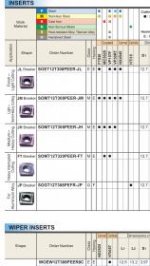graemeian
Plastic
- Joined
- Dec 24, 2010
- Location
- north carolina
I have an Okuma CNC CAT 40 machine and I am using a 3" Mitsubishi mill to cut mild steel. It uses an SOMT12T308PEER insert. I have a 6 and a 8 insert holder and both are Mitsubishi brand. I am using Mitsubishi VP15TF grade inserts as it was chosen because I could run coolant per the literature. I want to save the paint inside my cabinet. I am getting very poor mileage with this grade. The inserts chip after about 20 minutes. With these two mills, I have tried using 2, 3, 4, 6, 8 inserts and still no success. I also have a small Mitsubishi mill that has round inserts and I also get chipping of the inserts.
I saw where people were using this grade dry. I tried it and the part got so hot, I thought it would stretch or crack my Kurt vise.
What am I doing wrong?
I have a Valenite two insert chamfer tool that can face mill cut for hours and I see the normal wear.
I saw where people were using this grade dry. I tried it and the part got so hot, I thought it would stretch or crack my Kurt vise.
What am I doing wrong?
I have a Valenite two insert chamfer tool that can face mill cut for hours and I see the normal wear.




